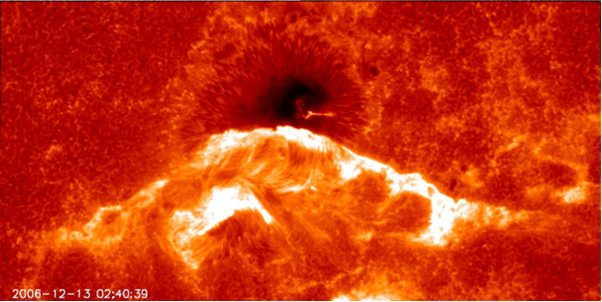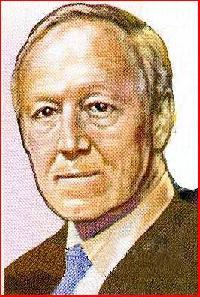Hannes Alfvén: the Maverick Plasma Astrophysicist - By Ian Tresman
Posted by ProjectC
<center>
Japan's Hinode solar telescope observes Alfvén waves in the Sun's corona.
Credit: Hinode/JAXA/NASA</center>
Hannes Alfvén: the Maverick Plasma Astrophysicist
By Ian Tresman
May 30, 2008
Source
100 years ago today on May 30th, 1908, Hannes Olof Gösta Alfvén was born in Norrköping, Sweden, about 100 miles southwest of Stockholm.
Hannes Alfvén is considered one of the founding fathers in the field of plasma physics. He described himself as a dissident scientist and maverick, and attitudes towards him are ambivalent. On the one hand, he received the 1970 Nobel Prize in physics for applications of his work in different areas of plasma physics. On the other hand, some of his contributions to science have been either ignored, forgotten, or unacknowledged.
After obtaining degrees in theoretical and experimental physics and in mathematics, Alfvén was awarded a doctorate for his thesis, “Investigations of the Ultra-Short Electromagnetic Waves". He soon moved into electronics and astronomy, however, after becoming interested in cosmic rays and in 1933 having his paper published in the journal Nature. All of his subsequent work was guided by the principle that all new theories must be consistent with experimental results from the laboratory, since the laws of Nature must apply everywhere.
In 1937 Alfvén suggested that interstellar galactic space was permeated by ions (a plasma) and could also carry electric and magnetic fields. By 1942, Alfvén had devised a theory regarding the origin of the Solar System from a cloud of ionized gas, and he noted "electromagnetic forces have been more important than mechanical forces".
<center>
<i>Hannes Alfvén on a postage stamp
from the Republic of the Congo</i></center>
Around this time, Alfvén revisited the work initiated by Kristian Birkeland on the Earth's aurora. As a result he developed the guiding-center approximation, a way to approximate the motion of a charged particle in a magnetic field. At that time it was taking two weeks to make the calculations. He also developed the concept of frozen-in magnetic field lines, which is widely used today but which Alfvén later warned can be highly misleading.
This work led to Alfvén's basic formulation of plasma physics, magnetohydrodynamics, which is the study of electrically conducting fluid dynamics. Alfvén first predicted that waves could occur in plasmas in a letter in Nature in 1942, but it was largely ignored or disputed on the grounds that if such waves existed, Maxwell would have noted them. Then in 1949, Alfvén gave a lecture in Chicago that Enrico Fermi also attended. Fermi’s reputation was such that when he nodded in agreement with Alfvén's presentation, the next day the world acknowledged that such waves existed.
Alfvén also predicted (with Nicolai Herlofson) cosmic synchrotron radiation, which is characteristic of electrons moving in magnetic fields. He also proposed a mechanism by which a moving gas can be ionized when it reaches a certain speed, called the critical ionization velocity. He also predicted the existence of rings around Uranus.
Hannes Alfvén biographical memoirs:
(Proceedings of the American Philosophical Society, Vol. 150, No. 4, 2005.)
http://www.aps-pub.com/proceedings/1504/150412.pdf
"Hannes Olof Gosta Alfven. 30 May 1908-2 April 1995", R. S. Pease; S. Lindqvist, in Biographical Memoirs of Fellows of the Royal Society, Vol. 44, Nov. 1998 (Nov., 1998), pp. 2-19.
http://www.journals.royalsoc.ac.uk/content/f3207q54p22x3362/fulltext.pdf
Hannes Alfvén (1908 - 1995), Alfvén Laboratory, Sweden.
http://www.alfvenlab.kth.se/hannes.html
Hannes Alfvén bibliography:
http://www.plasma-universe.com/index.php/Hannes_Alfv%C3%A9n_bibliography
Contributed by Ian Tresman
www.plasma-universe.com/

Japan's Hinode solar telescope observes Alfvén waves in the Sun's corona.
Credit: Hinode/JAXA/NASA</center>
Hannes Alfvén: the Maverick Plasma Astrophysicist
By Ian Tresman
May 30, 2008
Source
100 years ago today on May 30th, 1908, Hannes Olof Gösta Alfvén was born in Norrköping, Sweden, about 100 miles southwest of Stockholm.
Hannes Alfvén is considered one of the founding fathers in the field of plasma physics. He described himself as a dissident scientist and maverick, and attitudes towards him are ambivalent. On the one hand, he received the 1970 Nobel Prize in physics for applications of his work in different areas of plasma physics. On the other hand, some of his contributions to science have been either ignored, forgotten, or unacknowledged.
After obtaining degrees in theoretical and experimental physics and in mathematics, Alfvén was awarded a doctorate for his thesis, “Investigations of the Ultra-Short Electromagnetic Waves". He soon moved into electronics and astronomy, however, after becoming interested in cosmic rays and in 1933 having his paper published in the journal Nature. All of his subsequent work was guided by the principle that all new theories must be consistent with experimental results from the laboratory, since the laws of Nature must apply everywhere.
In 1937 Alfvén suggested that interstellar galactic space was permeated by ions (a plasma) and could also carry electric and magnetic fields. By 1942, Alfvén had devised a theory regarding the origin of the Solar System from a cloud of ionized gas, and he noted "electromagnetic forces have been more important than mechanical forces".
<center>

<i>Hannes Alfvén on a postage stamp
from the Republic of the Congo</i></center>
Around this time, Alfvén revisited the work initiated by Kristian Birkeland on the Earth's aurora. As a result he developed the guiding-center approximation, a way to approximate the motion of a charged particle in a magnetic field. At that time it was taking two weeks to make the calculations. He also developed the concept of frozen-in magnetic field lines, which is widely used today but which Alfvén later warned can be highly misleading.
This work led to Alfvén's basic formulation of plasma physics, magnetohydrodynamics, which is the study of electrically conducting fluid dynamics. Alfvén first predicted that waves could occur in plasmas in a letter in Nature in 1942, but it was largely ignored or disputed on the grounds that if such waves existed, Maxwell would have noted them. Then in 1949, Alfvén gave a lecture in Chicago that Enrico Fermi also attended. Fermi’s reputation was such that when he nodded in agreement with Alfvén's presentation, the next day the world acknowledged that such waves existed.
Alfvén also predicted (with Nicolai Herlofson) cosmic synchrotron radiation, which is characteristic of electrons moving in magnetic fields. He also proposed a mechanism by which a moving gas can be ionized when it reaches a certain speed, called the critical ionization velocity. He also predicted the existence of rings around Uranus.
Hannes Alfvén biographical memoirs:
(Proceedings of the American Philosophical Society, Vol. 150, No. 4, 2005.)
http://www.aps-pub.com/proceedings/1504/150412.pdf
"Hannes Olof Gosta Alfven. 30 May 1908-2 April 1995", R. S. Pease; S. Lindqvist, in Biographical Memoirs of Fellows of the Royal Society, Vol. 44, Nov. 1998 (Nov., 1998), pp. 2-19.
http://www.journals.royalsoc.ac.uk/content/f3207q54p22x3362/fulltext.pdf
Hannes Alfvén (1908 - 1995), Alfvén Laboratory, Sweden.
http://www.alfvenlab.kth.se/hannes.html
Hannes Alfvén bibliography:
http://www.plasma-universe.com/index.php/Hannes_Alfv%C3%A9n_bibliography
Contributed by Ian Tresman
www.plasma-universe.com/